制作深度学习目标检测数据集、数据集格式的转化及训练集和验证集的划分(基于Yolov5的目标检测项目)
Anaconda、pycharm、PyTorch等环境的配置此篇不做讲解,可参考其他博主的文章进行环境搭建。特别提醒:搭建环境时注意版本问题。
制作自己深度学习目标检测数据集
有很多可以直接下载数据集网站如:飞桨AI Studio、人脸识别常用数据集大全、Stanford University、国外大牛SVETLANA LAZEBNIK的数据集,但这些数据集种类有限,因此要学会根据自己的项目需要去制作自己的数据集。
制作数据集的工具有Adobe Photoshop、LabelImg等很多工具,可自己随便选择,因为Adobe Photoshop是收费的,所以我为大家提供了下载链接,懂得都懂
链接:https://pan.baidu.com/s/1QOVPWcwR07ddxGoIJNilVA?pwd=9988
提取码:9988
使用LabelImg工具为图片打标签
准备工作
因为需要标注图片数量较多所以用一下代码可为图片依次进行重命名编号, 'F:\Yolov5\测试图片1',将路径替换为自己图片文件夹的路径
import os
import shutil
folder_path = 'F:\Yolov5\测试图片1'
# 获取文件夹中的所有图片文件
images = [f for f in os.listdir(folder_path) if os.path.isfile(os.path.join(folder_path, f)) and f.lower().endswith(('.jpg', '.jpeg', '.png'))]
# 排序文件列表
images.sort()
# 设置开始命名时的数字,100会从101开始编号
start_number = 100
# 遍历图片并进行重命名
for i, image_name in enumerate(images):
new_filename = '{:03d}.{}'.format(start_number + i + 1, image_name.split('.')[-1])
old_filepath = os.path.join(folder_path, image_name)
new_filepath = os.path.join(folder_path, new_filename)
shutil.move(old_filepath, new_filepath)此代码会将每个图片的名称修改成这样有规律的格式方便寻找图片
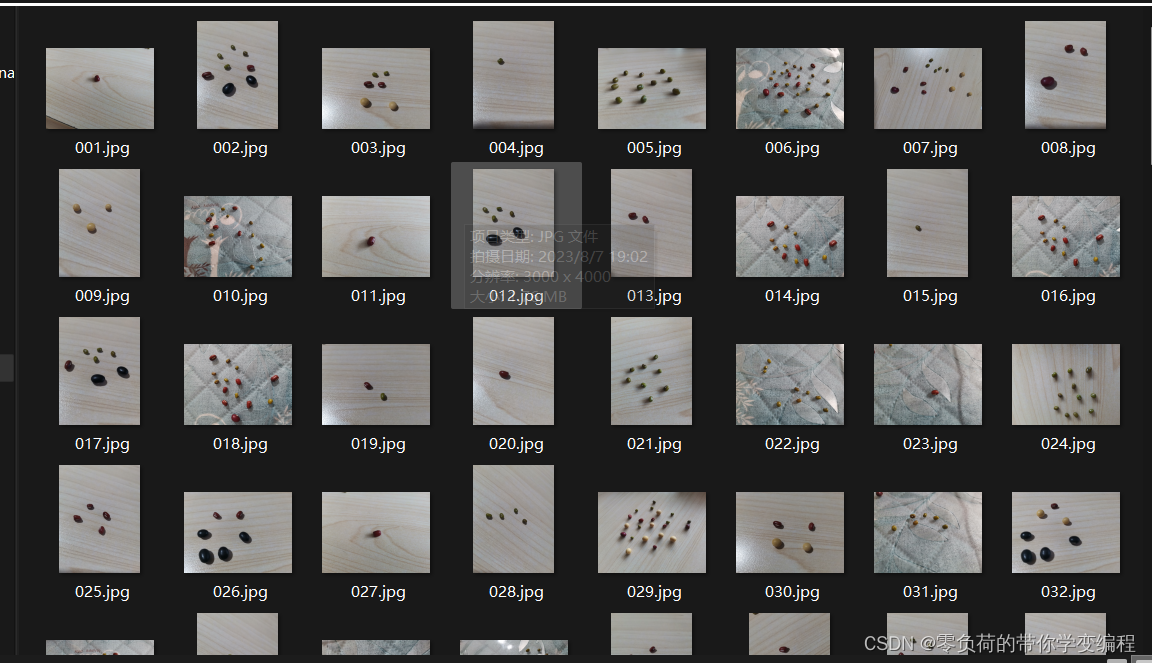
图片存放路径
图片的文件命名方式与存放位置请按照下图路径存放:命名一个VOCdevkit的文件夹在文件夹新建一个名为VOC2007的文件夹,VOC2007文件夹下有以下文件(文件夹不要放乱,否则在下面训练集与验证集划分时会有报错)
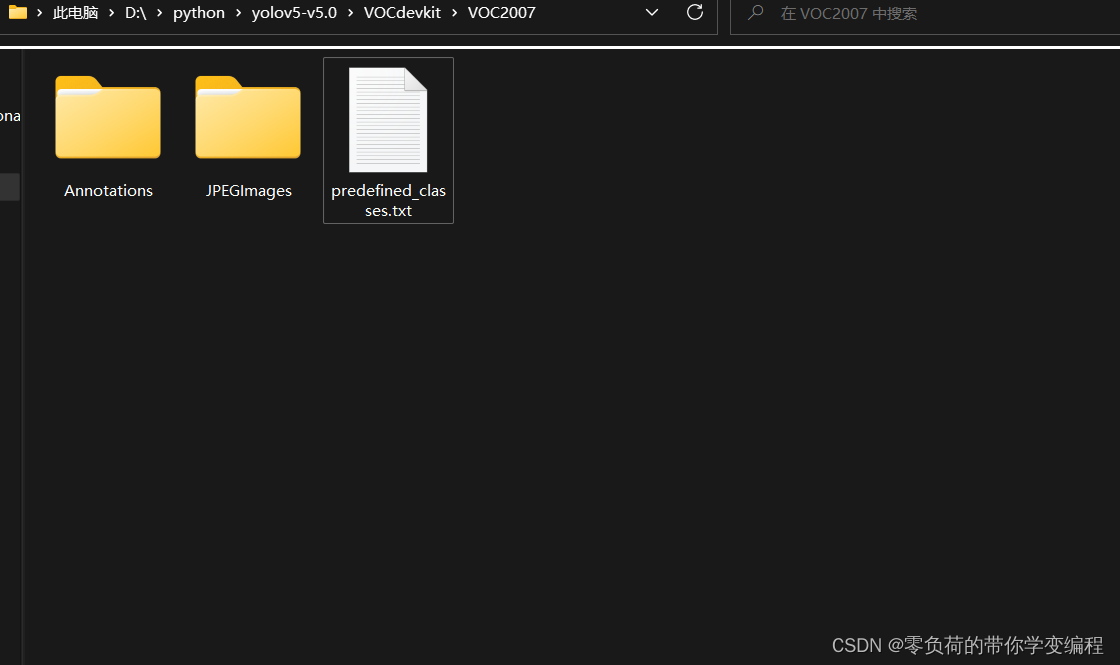
predefined_classes.txt:是要标注的标签种类,
JPEGImages:文件夹下存放的是各类图片
Annotations:该文件夹下存放的是打标签后的标签信息,是xml文件
在VOC2007文件夹下创建这两个文件夹和一个文本文件即可
进入Anaconda Prompt终端,打开labelimg标签工具
切换到自己的python环境下的VOC2007文件夹下,打开labelimg标签工具(该过程是我切换路径的方法,每个人环境名字和路径可能不一样注意更改)
(base) C:\Users\DELL>conda activate env38
(env38) C:\Users\DELL>D:
(env38) D:\>cd python
(env38) D:\python>cd yolov5-v5.0
(env38) D:\python\yolov5-v5.0>cd VOCdevkit
(env38) D:\python\yolov5-v5.0\VOCdevkit>cd VOC2007
(env38) D:\python\yolov5-v5.0\VOCdevkit\VOC2007>labelimg JPEGImages predefined_classes.txt
点击Change Save Dir选择Annotations文件,该文件夹是标签保存位置,在View工具栏勾选如图所示工具,勾选后会自动保存标签后的信息。
常用快捷键:
W:召唤标签框
A:切换上一张图片
D:切换下一张图片
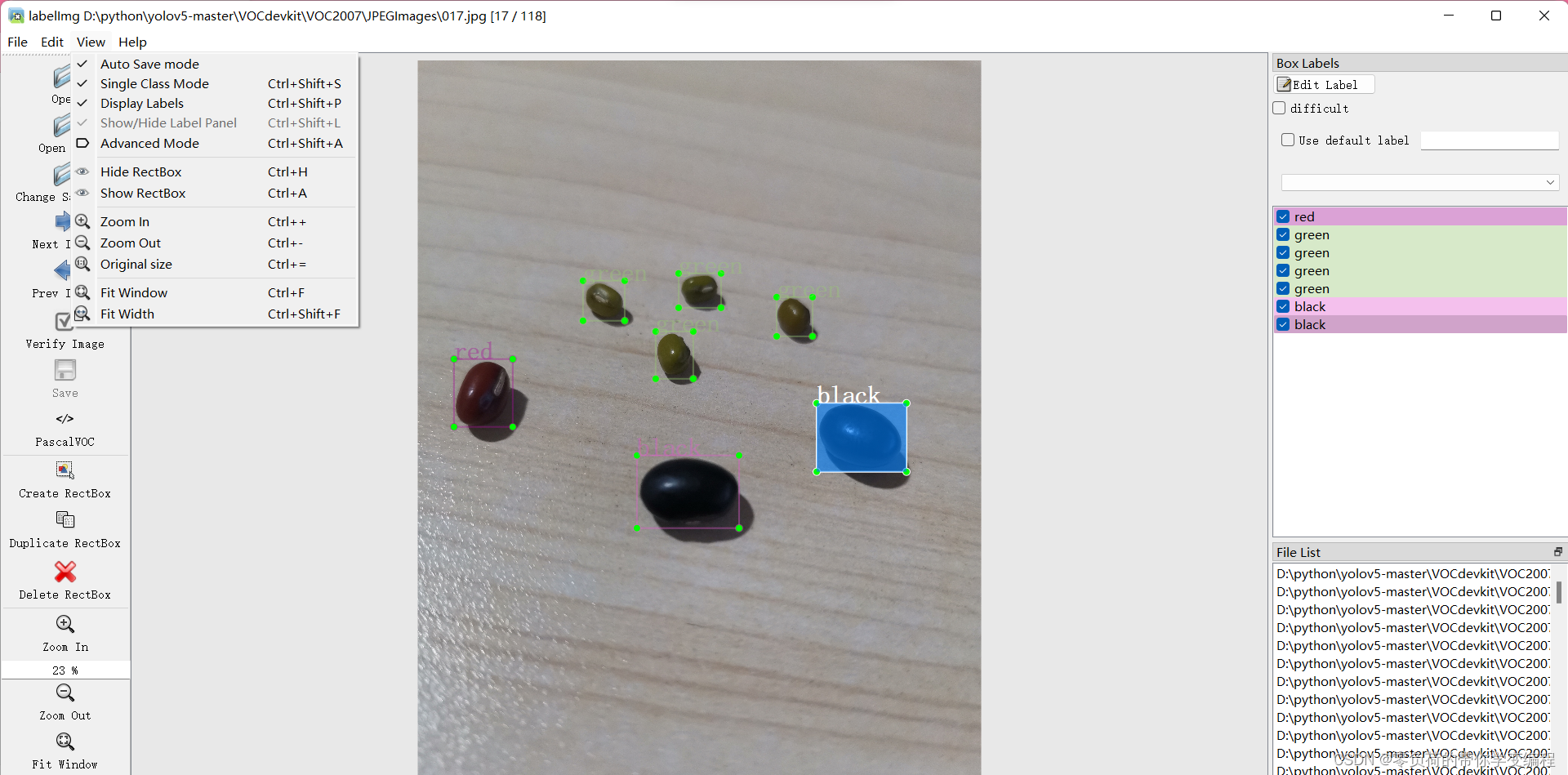
打完标签后Annotations文件后会有关于标签的xml文件信息
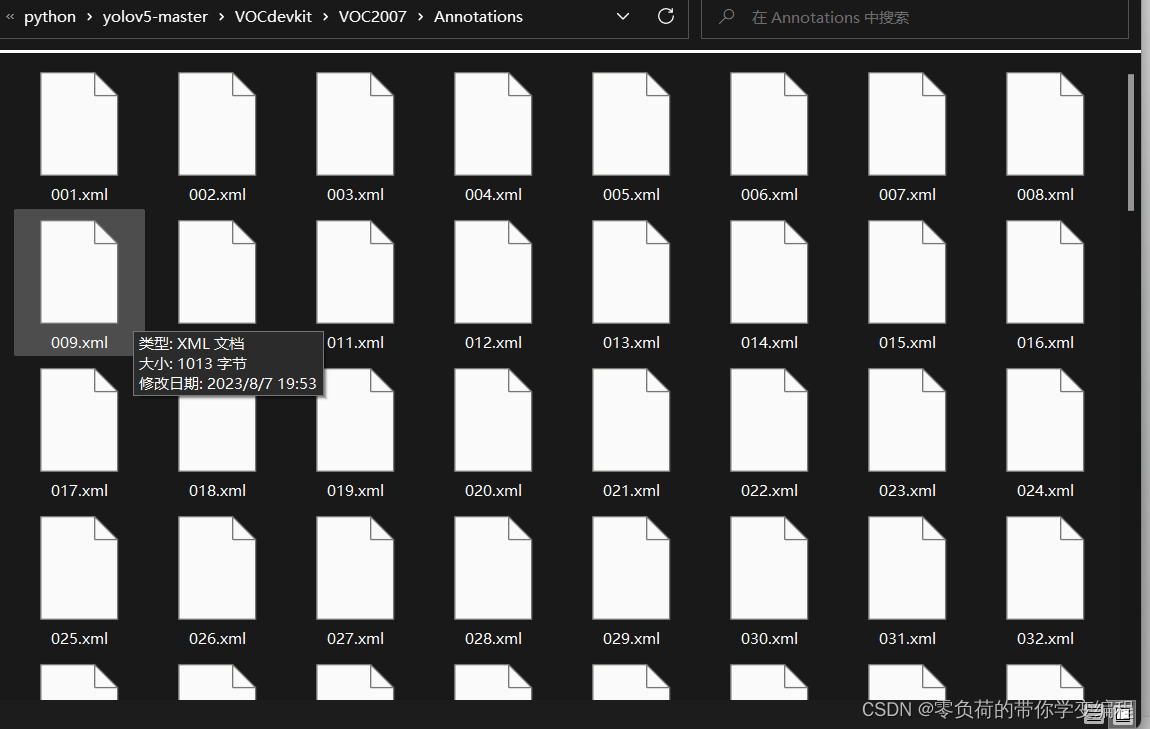
数据集格式的转化及训练集和验证集的划分
需要将xml文件格式改成txt格式
以下代码可以将xml文件格式改为txt文件,dic字典中的标签修改成自己设定的标签
from xml.dom.minidom import Document
import os
import cv2
def makexml(picPath, txtPath, xmlPath):
dic = {'0': "<标签0>",
'1': "<标签1>",
'2': "<标签2>",
'3': "<标签3>"}
files = os.listdir(txtPath)
for i, name in enumerate(files):
xmlBuilder = Document()
annotation = xmlBuilder.createElement("annotation") # 创建annotation标签
xmlBuilder.appendChild(annotation)
txtFile = open(txtPath + name)
txtList = txtFile.readlines()
img = cv2.imread(picPath + name[0:-4] + ".jpg")
Pheight, Pwidth, Pdepth = img.shape
folder = xmlBuilder.createElement("folder") # folder标签
foldercontent = xmlBuilder.createTextNode("driving_annotation_dataset")
folder.appendChild(foldercontent)
annotation.appendChild(folder) # folder标签结束
filename = xmlBuilder.createElement("filename") # filename标签
filenamecontent = xmlBuilder.createTextNode(name[0:-4] + ".jpg")
filename.appendChild(filenamecontent)
annotation.appendChild(filename) # filename标签结束
size = xmlBuilder.createElement("size") # size标签
width = xmlBuilder.createElement("width") # size子标签width
widthcontent = xmlBuilder.createTextNode(str(Pwidth))
width.appendChild(widthcontent)
size.appendChild(width) # size子标签width结束
height = xmlBuilder.createElement("height") # size子标签height
heightcontent = xmlBuilder.createTextNode(str(Pheight))
height.appendChild(heightcontent)
size.appendChild(height) # size子标签height结束
depth = xmlBuilder.createElement("depth") # size子标签depth
depthcontent = xmlBuilder.createTextNode(str(Pdepth))
depth.appendChild(depthcontent)
size.appendChild(depth) # size子标签depth结束
annotation.appendChild(size) # size标签结束
for j in txtList:
oneline = j.strip().split(" ")
object = xmlBuilder.createElement("object") # object 标签
picname = xmlBuilder.createElement("name") # name标签
namecontent = xmlBuilder.createTextNode(dic[oneline[0]])
picname.appendChild(namecontent)
object.appendChild(picname) # name标签结束
pose = xmlBuilder.createElement("pose") # pose标签
posecontent = xmlBuilder.createTextNode("Unspecified")
pose.appendChild(posecontent)
object.appendChild(pose) # pose标签结束
truncated = xmlBuilder.createElement("truncated") # truncated标签
truncatedContent = xmlBuilder.createTextNode("0")
truncated.appendChild(truncatedContent)
object.appendChild(truncated) # truncated标签结束
difficult = xmlBuilder.createElement("difficult") # difficult标签
difficultcontent = xmlBuilder.createTextNode("0")
difficult.appendChild(difficultcontent)
object.appendChild(difficult) # difficult标签结束
bndbox = xmlBuilder.createElement("bndbox") # bndbox标签
xmin = xmlBuilder.createElement("xmin") # xmin标签
mathData = int(((float(oneline[1])) * Pwidth + 1) - (float(oneline[3])) * 0.5 * Pwidth)
xminContent = xmlBuilder.createTextNode(str(mathData))
xmin.appendChild(xminContent)
bndbox.appendChild(xmin) # xmin标签结束
ymin = xmlBuilder.createElement("ymin") # ymin标签
mathData = int(((float(oneline[2])) * Pheight + 1) - (float(oneline[4])) * 0.5 * Pheight)
yminContent = xmlBuilder.createTextNode(str(mathData))
ymin.appendChild(yminContent)
bndbox.appendChild(ymin) # ymin标签结束
xmax = xmlBuilder.createElement("xmax") # xmax标签
mathData = int(((float(oneline[1])) * Pwidth + 1) + (float(oneline[3])) * 0.5 * Pwidth)
xmaxContent = xmlBuilder.createTextNode(str(mathData))
xmax.appendChild(xmaxContent)
bndbox.appendChild(xmax) # xmax标签结束
ymax = xmlBuilder.createElement("ymax") # ymax标签
mathData = int(((float(oneline[2])) * Pheight + 1) + (float(oneline[4])) * 0.5 * Pheight)
ymaxContent = xmlBuilder.createTextNode(str(mathData))
ymax.appendChild(ymaxContent)
bndbox.appendChild(ymax) # ymax标签结束
object.appendChild(bndbox) # bndbox标签结束
annotation.appendChild(object) # object标签结束
f = open(xmlPath + name[0:-4] + ".xml", 'w')
xmlBuilder.writexml(f, indent='\t', newl='\n', addindent='\t', encoding='utf-8')
f.close()
if __name__ == "__main__":
picPath = "VOCdevkit/VOC2007/JPEGImages/" # 图片所在文件夹路径,后面的/一定要带上
txtPath = "VOCdevkit/VOC2007/YOLO/" # txt所在文件夹路径,后面的/一定要带上
xmlPath = "VOCdevkit/VOC2007/Annotations/" # xml文件保存路径,后面的/一定要带上
makexml(picPath, txtPath, xmlPath)
运行完后会在VOC2007文件夹下生成YOLOLabels文件夹,该文件下的内容是我们需要的txt文件
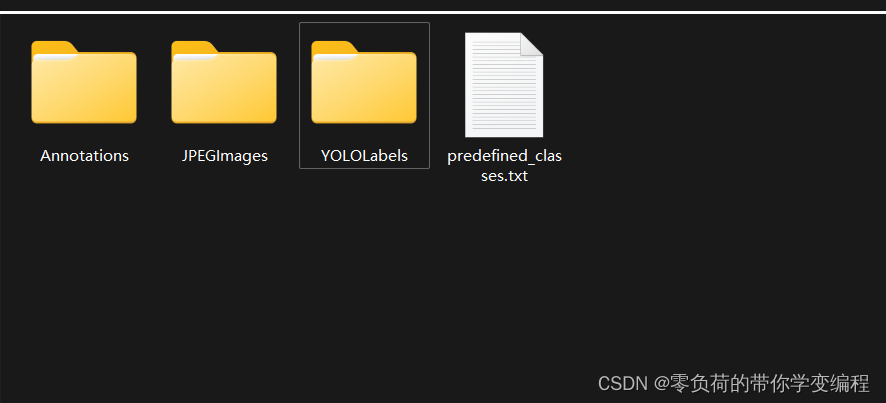
训练集和验证集的划分
运行下面代码会划分出验证集和训练集,classes数组中的标签替换成自己的内容,TRAIN_RATIO=80定义的是训练集与验证集的比例,其中80%的训练集,20%的验证集。(可根据需求自己修改)
import xml.etree.ElementTree as ET
import pickle
import os
from os import listdir, getcwd
from os.path import join
import random
from shutil import copyfile
classes = ["<标签0>","<标签1>","<标签2>","<标签3>"]
TRAIN_RATIO = 80
def clear_hidden_files(path):
dir_list = os.listdir(path)
for i in dir_list:
abspath = os.path.join(os.path.abspath(path), i)
if os.path.isfile(abspath):
if i.startswith("._"):
os.remove(abspath)
else:
clear_hidden_files(abspath)
def convert(size, box):
dw = 1. / size[0]
dh = 1. / size[1]
x = (box[0] + box[1]) / 2.0
y = (box[2] + box[3]) / 2.0
w = box[1] - box[0]
h = box[3] - box[2]
x = x * dw
w = w * dw
y = y * dh
h = h * dh
return (x, y, w, h)
def convert_annotation(image_id):
in_file = open('VOCdevkit/VOC2007/Annotations/%s.xml' % image_id)
out_file = open('VOCdevkit/VOC2007/YOLOLabels/%s.txt' % image_id, 'w')
tree = ET.parse(in_file)
root = tree.getroot()
size = root.find('size')
w = int(size.find('width').text)
h = int(size.find('height').text)
for obj in root.iter('object'):
difficult = obj.find('difficult').text
cls = obj.find('name').text
if cls not in classes or int(difficult) == 1:
continue
cls_id = classes.index(cls)
xmlbox = obj.find('bndbox')
b = (float(xmlbox.find('xmin').text), float(xmlbox.find('xmax').text), float(xmlbox.find('ymin').text),
float(xmlbox.find('ymax').text))
bb = convert((w, h), b)
out_file.write(str(cls_id) + " " + " ".join([str(a) for a in bb]) + '\n')
in_file.close()
out_file.close()
wd = os.getcwd()
wd = os.getcwd()
data_base_dir = os.path.join(wd, "VOCdevkit/")
if not os.path.isdir(data_base_dir):
os.mkdir(data_base_dir)
work_sapce_dir = os.path.join(data_base_dir, "VOC2007/")
if not os.path.isdir(work_sapce_dir):
os.mkdir(work_sapce_dir)
annotation_dir = os.path.join(work_sapce_dir, "Annotations/")
if not os.path.isdir(annotation_dir):
os.mkdir(annotation_dir)
clear_hidden_files(annotation_dir)
image_dir = os.path.join(work_sapce_dir, "JPEGImages/")
if not os.path.isdir(image_dir):
os.mkdir(image_dir)
clear_hidden_files(image_dir)
yolo_labels_dir = os.path.join(work_sapce_dir, "YOLOLabels/")
if not os.path.isdir(yolo_labels_dir):
os.mkdir(yolo_labels_dir)
clear_hidden_files(yolo_labels_dir)
yolov5_images_dir = os.path.join(data_base_dir, "images/")
if not os.path.isdir(yolov5_images_dir):
os.mkdir(yolov5_images_dir)
clear_hidden_files(yolov5_images_dir)
yolov5_labels_dir = os.path.join(data_base_dir, "labels/")
if not os.path.isdir(yolov5_labels_dir):
os.mkdir(yolov5_labels_dir)
clear_hidden_files(yolov5_labels_dir)
yolov5_images_train_dir = os.path.join(yolov5_images_dir, "train/")
if not os.path.isdir(yolov5_images_train_dir):
os.mkdir(yolov5_images_train_dir)
clear_hidden_files(yolov5_images_train_dir)
yolov5_images_test_dir = os.path.join(yolov5_images_dir, "val/")
if not os.path.isdir(yolov5_images_test_dir):
os.mkdir(yolov5_images_test_dir)
clear_hidden_files(yolov5_images_test_dir)
yolov5_labels_train_dir = os.path.join(yolov5_labels_dir, "train/")
if not os.path.isdir(yolov5_labels_train_dir):
os.mkdir(yolov5_labels_train_dir)
clear_hidden_files(yolov5_labels_train_dir)
yolov5_labels_test_dir = os.path.join(yolov5_labels_dir, "val/")
if not os.path.isdir(yolov5_labels_test_dir):
os.mkdir(yolov5_labels_test_dir)
clear_hidden_files(yolov5_labels_test_dir)
train_file = open(os.path.join(wd, "yolov5_train.txt"), 'w')
test_file = open(os.path.join(wd, "yolov5_val.txt"), 'w')
train_file.close()
test_file.close()
train_file = open(os.path.join(wd, "yolov5_train.txt"), 'a')
test_file = open(os.path.join(wd, "yolov5_val.txt"), 'a')
list_imgs = os.listdir(image_dir) # list image files
prob = random.randint(1, 100)
print("Probability: %d" % prob)
for i in range(0, len(list_imgs)):
path = os.path.join(image_dir, list_imgs[i])
if os.path.isfile(path):
image_path = image_dir + list_imgs[i]
voc_path = list_imgs[i]
(nameWithoutExtention, extention) = os.path.splitext(os.path.basename(image_path))
(voc_nameWithoutExtention, voc_extention) = os.path.splitext(os.path.basename(voc_path))
annotation_name = nameWithoutExtention + '.xml'
annotation_path = os.path.join(annotation_dir, annotation_name)
label_name = nameWithoutExtention + '.txt'
label_path = os.path.join(yolo_labels_dir, label_name)
prob = random.randint(1, 100)
print("Probability: %d" % prob)
if (prob < TRAIN_RATIO): # train dataset
if os.path.exists(annotation_path):
train_file.write(image_path + '\n')
convert_annotation(nameWithoutExtention) # convert label
copyfile(image_path, yolov5_images_train_dir + voc_path)
copyfile(label_path, yolov5_labels_train_dir + label_name)
else: # test dataset
if os.path.exists(annotation_path):
test_file.write(image_path + '\n')
convert_annotation(nameWithoutExtention) # convert label
copyfile(image_path, yolov5_images_test_dir + voc_path)
copyfile(label_path, yolov5_labels_test_dir + label_name)
train_file.close()
test_file.close()查看VOCdevkit文件夹(在该文件夹中有images与labels文件夹即数据集划分成功)
images文件夹下保存的是训练集和验证集的图片(train文件夹下训练集图片;val文件夹下验证集图片)
labels文件夹下保存的是训练集和验证集的标签信息(train文件夹下是训练集txt文件;val文件夹下是验证集txt文件)

到此处数据集划分全部完成
下一篇:教你利用yolov5通过上文标注的数据集训练自己的目标检测模型